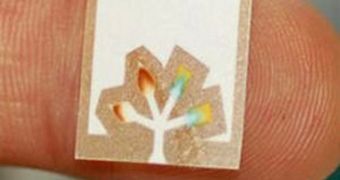A group of experts at the Harvard University, led by chemistry professor George Whitesides, is aiming to develop a new paper lab-on-a-chip, which would act like a blood analyzer and will cost about a penny. The new scientific instrument will be no larger than the tip of a finger, and its primary function is to be used in areas of the world where more advanced scientific equipments cannot be delivered or afforded to or by the local population. The device will, however, be able to recognize signs of the most widespread diseases in the developing world, such as HIV, malaria, hepatitis, gastroenteritis and tuberculosis, PhysOrg reports.
Whitesides announces that a prototype of the new instrument has already been developed, and is appearing to work very well. The lab-on-a-chip is humble in appearance, being made entirely out of paper. It is very small, and features a tree-shaped pattern on its surface, that is its active components. The trick is to print the “tree” using water-repellent ink, of the variety usually employed in printing comic books. The chemistry expert explains that this particular type of ink is able to saturate several layers of paper, and thus push the blood through channels that are layered with diagnostics paper.
Using the instrument will be equally as simple. People being tested will simply place a drop of blood on one end of the device, and then wait for a few minutes. At the end of this time interval, a pattern of several colors will appear at the other end of the small piece of paper, indicating to professionals carrying out the investigations whether or not their patients suffer from any of the diseases the chip can test for. In addition, the chip can also show the seriousness of the condition, and not only indicate its presence or absence.
According to Whitesides, batches of the new scientific instrument will be available within 12 months. However, he underlines that there are still some problems that the team needs to solve, which are not caused by the device itself. As many of these chips will travel to the poorest region of the world, in Africa mostly, they will be subjected to a type of climate that will favor the development of molds on them. This needs to be prevented at all costs, so as not to hinder the results of the study. In addition, placing a diagnostic on an individual means nothing if the appropriate course of treatment is not followed, so healthcare experts will need to accompany those making the diagnostics via this chip.

 14 DAY TRIAL //
14 DAY TRIAL //